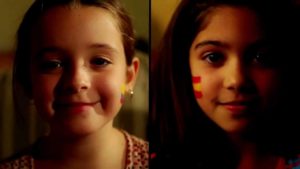If you haven’t seen the video Vidas paralelas, watch it here first. You might even need to watch it again, just to make sure you don’t miss anything. Now, after you’ve maybe felt a strong wave of emotions, let’s talk about what an awesome video it is for students! Not only is this an authentic resource, but it is a beautifully put together video that challenges stereotypes and our preconceived notions. My favorite part is when my students realize the ending of María and Sofía’s stories, it is one of those lightbulb moments we teachers dream of. Originally when I found this video I was searching for videos for my Spanish 2 Mi rutina diaria unit and did actually show it to my Spanish 2 students a few times, even though I had to really walk them through it. I’ve had the best success in showing the video to my Spanish 5 students, not surprisingly their language skills are more developed so even though they have to watch it 2-3 times to really understand each piece of the video, the ah-ha moment is amazing because they get there on their own. I also use this worksheet to keep them organized while watching and I constantly remind them that María is always on the left and Sofía is always on the right. Once we’re done watching the video, I give them a chance to reflect on what they experienced while watching, what they think the message of the video is, who the video was made for and about the impact of stereotypes. I give them time to write about their thoughts and then have them discuss in small groups and share what they thought of the video. We finish with a large group share out from each group. Since these are Spanish 5 students they can do all of this in Spanish since it ties into their globalization unit.

I know that some people might find this video risky to show to students, it can hit on some controversial topics, but ultimately the video is about how everyone has something to offer everyone else and we should be united. The day I show this video has become one of my favorite days of the semester, because I watch my students use their language skills to understand a powerful message and then discuss their thoughts with each other. I also use it as a jumping off point to talk about the connections that still exist between Spain and Latin America. Obviously it is a complex topic and one that can’t be covered in a day, but it gives us a place to start and opens my students’ eyes to the world beyond the United States and helps them see things are complicated everywhere.
